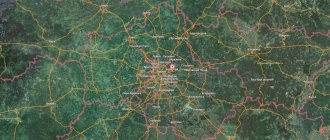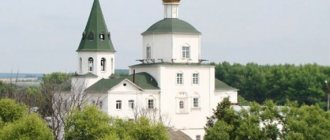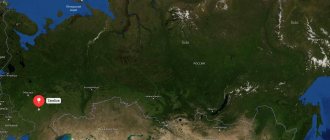Dubna
(until 1958 -
Dubno
), a city of regional subordination in the Moscow region, within the Dubna-Taldom deanery of the Sergiev Posad diocese. Located in the northernmost point of the Moscow region, on the banks of the Volga River, bounded by the Dubnaya and Sestra rivers, the Moscow Canal and the Ivankovsky Reservoir, 125 km from Moscow. The only settlement in the Moscow region located on the Volga. Population 67.9 thousand people (2010)
- On the map: Yandex.Map, Google map
The city of Dubna is known throughout the world as a major scientific center. Scientists from many countries around the world have been fruitfully collaborating here for more than half a century. This is the only Russian settlement immortalized in the Periodic Table of Elements by D.I. Mendeleev: “tannium” is the name of the chemical element 105 discovered by city scientists.
The confluence of the Volga and Dubna rivers was first mentioned in the Novgorod Chronicle in 1134. In 1216, during the war between the Novgorod Republic and the Vladimir-Suzdal Principality, the settlement that existed here was burned by the Novgorodians and was not restored afterwards. Subsequently, the village of Gorodishche and the village of Ratmino arose here.
The village of Ivankovo, located on the left bank of the Volga, was first mentioned in the 18th century. The nearest village of Podberezye has been known since the century, and the village of Yurkino on the Dubna River has been known since the 16th century. The village of Aleksandrovka was founded after the peasant reform in 1861. Here the landowner Prince A.S. Vyazemsky resettled part of the peasants living in the village of Ratmino, giving them land. The village of Kozlaki appeared in the same period. The inhabitants of these villages and the village of Gorodishche were mainly engaged in arable farming, shoemaking and fishing.
In the early 30s of the century, radical changes occurred in the life of the local population, which was associated with the construction of the Moscow Canal and the first Ivankovskaya hydroelectric power station on the Volga. Several surrounding villages were relocated. The village of Ivankovo was among them. Its inhabitants were resettled 4 km downstream of the Volga. And it began to be called Novo-Ivankovo. After the construction of the Volga hydraulic structures was completed in 1937, the workers' settlement of Bolshaya Volga began to grow nearby. Simultaneously with the construction of the Moscow Canal on the left bank of the Volga, the construction of an aviation enterprise was underway, next to which the aircraft manufacturing village of Ivankovo arose.
During the Great Patriotic War, Nazi troops were stopped 20 km from the villages of Ivankovo and Bolshaya Volga. They became frontline territory. Separate units, military courses and a hospital of the 30th Army of the Western Front were located here.
On the right bank of the Volga, near the village of Novo-Ivankovo, in 1947, on the initiative of the head of the Soviet atomic project I.V. Kurchatov began the creation of the world's largest charged particle accelerator in those years - the synchrocyclotron, which was launched in 1949. Dubno in 1954.
.
In 1953, the Institute of Nuclear Problems of the USSR Academy of Sciences was formed on the basis of the Hydrotechnical Laboratory of the USSR Academy of Sciences. After the creation by Western European countries of a nuclear research center (CERN) in the city of Geneva, in contrast to it, on the initiative of the Soviet Union, the Joint Institute for Nuclear Research (JINR) was formed in Dubno in March 1956.
On July 24, 1956, by Decree of the Presidium of the Supreme Soviet of the RSFSR, it was transformed into a city, and later transferred from the Kalinin region to the Moscow region. The village of Bolshaya Volga, the villages of Ratmino, Novo-Ivankovo, Aleksandrovka, Yurkino and Kozloki were annexed to it. In 1958 it became known as the city of Dubna
. The development of the new city was determined by the expansion of JINR.
On the left bank, the village of Ivankovo continued to develop, where, since 1939, the aviation enterprise produced aviation and missile equipment necessary for the defense of the country. In 1958, it was transformed into a city and transferred to the Moscow region, and in December 1960 it was merged with Dubna.
Since 1964, in Dubna, in accordance with the first master plan, the creation of a unified architectural and planning ensemble of the city began. This plan was further developed in a new master plan approved in 1984.
A new impetus to the development of Dubna, especially the oldest district of the city “Big Volga”, was given by the construction, which began in 1969, of the instrumentation plant, which already in 1973 produced its first products - instruments for nuclear power plants of the Soviet Union and CMEA member countries. In 1976, the Federal State Unitary Enterprise Research Institute “Atoll” was located in the same microdistrict, where the development of control systems for water areas of the Soviet Union began.
The city of Dubna is the largest scientific and industrial center in Russia and the Moscow region, with a developed system of education, culture, and healthcare, where high standards of living of the population were ensured.
In 1980, in connection with the opening of the XXII Olympic Games held in Moscow, the Dubna Space Communications Center began operating in Dubna, providing television broadcasts to the regions of Europe and the Atlantic Ocean and stable government telephone communications with the UK, USA, and France. Since that time, Dubna has become a major international teleport.
During the reform period of the 1990s, Dubna managed to maintain the profile of scientific and production activities and lay the foundations for innovative development.
In 1994, Dubna became a university center. The State International University of Nature, Society and Man “Dubna” was opened here.
In December 2001, by Decree of the President of the Russian Federation V.V. Putin, the city was given the status of a science city and a program for its development was approved.
In 2005, by decree of the government of the Russian Federation (dated December 21, 2005 No. 781), it was decided to create a special economic zone of a technology-innovation type in the city of Dubna.
Conferences “Science. Philosophy. Religion"
From 1990 to 1999, annual conferences “Science. Philosophy. Religion", the goal of which was to overcome the disunity between secular and church science and stereotypical ideas about the opposition between science and religion, inherited from the philosophy of the New Age, as well as the formation in the public consciousness of ideological positions that harmoniously combine religious, philosophical and scientific aspects of knowledge. Famous scientists and professors and teachers of higher educational institutions of the capital, and representatives of the clergy, professors and teachers of theological schools took part in the conferences.
After a long break, the tradition of holding annual conferences was resumed in 2007.
Soviet time
At the entrance to the canal, two monumental figures of the leaders of the world proletariat were installed - Lenin and Stalin.
To this day, the population of Dubna sees a monument to Vladimir Ilyich on the banks of the Volga, looking at the Volga. The figure of Stalin was dismantled after his death.
During the Great Patriotic War, the dam and hydroelectric power station in Dubna became strategic objects. Indeed, if they are destroyed, Moscow will be left without water and electricity, factories in the rear will stop, settlements and enterprises will be flooded. To protect the structures and the city, the dam's gates were opened, the water level dropped, the ice broke, and the German troops who entered the reservoir went under water. The Nazi offensive failed.
Religion
In a city founded in the era of developed socialism, the plan did not include places of worship. However, in a picturesque place - the spout of the Dubna and Volga rivers, there is the Church of the Praise of the Blessed Virgin Mary, built in 1827.
In the winter of 1993, in the area of the city cemetery of Dubna, a Temple was founded in the name of All Saints who shone in the Russian land.
In the summer of 1995, construction began on the Temple of the Smolensk Icon of the Mother of God in the left bank part of the city of Dubna in the old cemetery.
In the spring of 2000, an initiative group arose in Dubna advocating the construction of the Church of the Nativity of John the Baptist, the construction of which began in August of the same year.
Until 1994, Dubna was part of the Dmitrovsky deanery district of the Moscow regional diocese. In 1994, due to the increase in the number of parishes, the Taldomsky deanery district was established, which includes churches in the city of Dubna and the Taldomsky district. On October 9, 2007, at the diocesan meeting of the Moscow diocese, the Taldom deanery was renamed the Dubna-Taldom deanery with its center in the city of Dubna.
Since April 13, 2022, the city of Dubna has been part of the independent Sergiev Posad diocese as part of the Moscow Metropolis [1].
The city operates a non-state educational institution “Orthodox gymnasium “ODIGITRIA” at the Church of the Smolensk Icon of the Mother of God.”
The Saints
- sschmch. Mikhail Abramov (1885 - 1937), archpriest, rector of the Dubna Pokhvalinsky Church
Temples
- Epiphany, baptismal chapel at the Church of the Nativity of John the Baptist
- All saints who shone in the Russian land
- Daniel of Pereyaslavl, the temple-chapel is assigned to the Panteleimon Church
- Xenia of St. Petersburg (bell-baptismal tower at the Church of the Smolensk Icon of the Mother of God)
- Panteleimon the Healer
- Praises to the Blessed Virgin Mary
- Nativity of John the Baptist
- Smolensk Icon of the Mother of God
Second birth
In subsequent centuries, small settlements of Ratmino and Gorodishche were located in these places. In later times, these lands belonged to the landowners Tatishchev, professor P. Shubinsky, and entrepreneur I.P. Lyubomilov.
By the thirties of the 20th century, the population of Moscow had increased so much that there was not enough water. We returned to the issue raised by Peter I, about the transfer of Volga water to the city. Prisoners from correctional camps were involved in the construction of the Moscow-Volga canal. In September 1933, the first batch of workers in prison uniforms, called Canal Army soldiers, arrived in the village of Ivankovo. During the construction of 250 objects on the canal (dams, pumping stations, locks, berths, etc.), huge areas of land were added to the construction, which entailed the relocation of people and the filling of populated areas. The grandiose construction was completed in just four years, in March 1937. This is how the city of Dubna appeared again.
Science City
Today, production enterprises operating in Dubna are widely known throughout the world. There are also strictly classified objects.
State Medical Clinical Hospital "Raduga" named after. A. Ya. Bereznyak developed the P-15 Termit anti-ship missile back in 1955, with which the missile era at sea began.
It was manufactured at the Dubninsky Machine-Building Plant. It was these missiles that were to become the basis of Soviet combat missile production for the next half century. The bureau was created in 1951.
Dubninsky Machine-Building Plant named after. N.P. Fedorova initially had a different specificity. In the thirties of the 20th century, the question of creating seaplanes to protect the maritime borders of the USSR became acute.
The first production of such aircraft was established here and continued from 1939 to 1946. Joint work has brought our country to the forefront of developers and manufacturers of cruise technology, having mastered more than 50 types of modern missiles.
In 1945, after the explosion of nuclear bombs in Hiroshima and Nagasaki, humanity entered a new nuclear era. The first proton accelerator was built in Dubna and was launched in 1949. This is how high-energy physics arose in the Soviet Union. The Nuclear Testing Institute, a strictly classified organization, was initially called, for purposes of secrecy, the Hydrotechnical Laboratory. Today, the population of Dubna is proud to live in a city of peaceful atoms; military nuclear development is not carried out here. In 1957, the giant synchrophasotron was launched. This was a victory for Soviet physics. Scientists from all over the country flocked to Dubna. Today, the institute is developing more than fifty applied projects.
The NIKA complex, a collider and heavy ion accelerator, operates in Dubna. Slightly smaller than the Swiss one, it allows scientists to carry out serious research work.
The Space Communications Center in Dubna has been providing government communications and organizing international radio and television broadcasting channels for more than a quarter of a century.
The Daedalus Research and Production Complex produces the most modern and advanced means of border security for all branches of the military. Their customers also include nuclear power plants and oil and gas complex facilities. They were engaged in technical security of the Olympic complex in Sochi.
Sport
Stele at the entrance to the city
There are five sports complexes and three swimming pools in Dubna.
The city has its own teams for:
- football - FC "Dubna".
- American football - “Vityazi”.
Sections and schools that have trained athletes at the level of Russian and world champions:
- Sambo school of Boris Pivovarov;
- water skiing school of the Nekhaevsky brothers;
- table tennis section at the JINR stadium;
- JINR Weightlifting Section.
In general, as of the beginning of 2009, there were sections and associations in more than 30 sports in the city.
Education and science
Coat of Arms (1976)
23 preschool institutions, 12 state and 3 non-state schools. Moscow Regional Industrial and Economic College, Moscow Regional Agrarian and Technological College, Center for Children and Youth Tourism and Excursions.
Universities:
- branch of the Moscow State University of Service (MGUS).
- representation of the International Academy of Assessment and Consulting (IAOC); (It does not work)
- branch of the Moscow State Institute of Radio Engineering, Electronics and Automation (Technical University);
- Research Institute of Nuclear Physics, Moscow State University;
- representative office of the University of the Russian Academy of Education (URAO);
- International University of Nature, Society and Human “Dubna”;
Peaceful city
With the advent of the accelerator, in the fifties, the residential part of the city began to actively develop, comfortable houses were built, people got good jobs and decent salaries. Many freedom-loving artists and musicians sought to come here; extraordinary concerts and performances took place here. Residents were actively involved in sports. Both young and world-famous nuclear physicists worked in Dubna.
In the eighties, the city was almost divided into two parts along the Volga river. A name has already been invented for the left bank part - Podberezovsk. Thanks to the intervention of Supreme Soviet deputy N.N. Bogolyubov, the city remains a single organism.
Today, about 700 enterprises in the field of applied science, nuclear energy, and communications operate here, employing almost half of Dubna’s population. Including about three hundred doctors, over 800 candidates of science, 10 academicians.
The Dubna city administration pays great attention to young residents. Recently, the Dubna University appeared here, aimed at developing a sustainable development strategy. It already occupies a worthy place among the best universities in the country.
References
Notes
- ^ a b c d f
Law No. 11/2013-OZ - ^ a b c
Federal State Statistics Service of Russia (2011).
“All-Russian Population Census 2010. Volume 1" [All-Russian Population Census 2010, vol. 1]. All-Russian Population Census 2010 [All-Russian Population Census 2010]
(in Russian). Federal State Statistics Service. - "26. The size of the permanent population of the Russian Federation by municipalities as of January 1, 2022.” Federal State Statistics Service. Retrieved January 23, 2022.
- ^ a b c
Law No. 84/2005-OZ - "On the calculation of time." Official Internet portal of legal information
(in Russian). June 3, 2011. Retrieved January 19, 2022. - Post office. Information and computing center of OASU RPO. ( Post office
).
Search for postal facilities ( Search for postal facilities
) (in Russian) - "Ground infrastructure". Russian satellite communications company
. - Federal State Statistics Service of Russia (May 21, 2004). “The population of Russia, the constituent entities of the Russian Federation as part of federal districts, urban settlements, urban settlements, settlements, settlements of 3 thousand or more people.” [Population of Russia, its federal districts, federal subjects, districts, urban settlements, rural settlements - administrative centers, rural settlements with a population of more than 3000 people] (XLS). All-Russian Population Census of 2002 [All-Russian Population Census of 2002]
(in Russian). - “All-Union Population Census 1989. Current population of union and autonomous republics, autonomous regions and districts, territories, regions, urban settlements and villagesMuzEnergo” Archived March 2, 2010 Wayback Machine
- Official list of museums in Dubna
- Official website of the organizing committee of the 2011 World Water Ski Championships Archived April 24, 2011 Wayback Machine
- Salis, Rimgaila (2009). Musical comedies by Grigory Alexandrov: to the point of laughter
. Books of intelligence. paragraph 271. - Dubna partnership
- pl: Dubna
Sources
- Moscow Regional Duma. Law No. 11 / 2013-OZ of January 31, 2013 “On the administrative-territorial structure of the Moscow region,” as amended. Law No. 249 / 2019-OZ of November 29, 2022 “On amendments to the Law of the Moscow Region” On the administrative-territorial structure of the Moscow Region “”. Came into force the day after official publication (January 13, 2013). Published: “Daily News. Moscow Region,” No. 24, February 12, 2013 (Moscow Regional Duma. Law No. 11/2013-OZ of January 31, 2013. On the administrative-territorial structure of the Moscow Region.
As amended by Law No. 249/2019-OZ of November 29, 2019.
On amendments to the Law of the Moscow Region “On the administrative-territorial structure of the Moscow Region.”
Valid from the day following the day of official publication (January 13, 2013).
- Moscow Regional Duma. Law No. 84 / 2005-OZ of February 28, 2005 “On the status and border of the Dubna urban district,” as amended. Law No. 52 / 2009-OZ of May 22, 2009 “On amendments to the Law of the Moscow Region” On the status and border of the Dubna urban district “”. Came into force on the date of official publication. Published: “Daily News. Moscow Region,” No. 44, March 12, 2005 (Moscow Regional Duma. Law No. 84/2005-OZ of February 28, 2005. On the status and border of the Dubna urban district.
As amended by Law No. 52/2009-OZ of May 22, 2009.
On amendments to the Law of the Moscow Region "On the status and border of the urban district of Dubna"
. Valid from the date of official publication.).
Demography
Historical population
| Year | Pop. | ±% |
| 1959 | 14,000 | — |
| 1970 | 43,700 | +212.1% |
| 1979 | 54,900 | +25.6% |
| 1989 | 65,800 | +19.9% |
| 2003 | 61,000 | −7.3% |
| 2008 | 62,500 | +2.5% |
| 2010[2] | 70,663 | +13.1% |
| 2012[11] | 72,357 | +2.4% |
| Source: [10] unless otherwise noted | ||
Geography
The city is 120 meters (390 ft) above sea level. sea level, located approximately 125 km (78 mi) north of Moscow, on the Volga River, just downstream of the Ivankovskoye Reservoir. The reservoir was formed by a hydroelectric power station. dam across the Volga within the city. The city is located on both banks of the Volga. The western border of the city is determined by the Canal named after. Moscow flows into the Volga, and the eastern border is determined by the Dubna River joining the Volga.
Dubna is the northernmost city in the Moscow region.
Climate
The studied area belongs to the zone of temperate continental climate, in which air masses of temperate latitudes predominate, transformed from marine air masses of the temperate and arctic zones, to the subzone of the southern taiga.
Due to the great variability of atmospheric circulation, weather variability and sometimes quite abrupt changes are observed. Winters are quite long and relatively cold, summers are moderately warm. In winter, along with persistent frosts, thaws are observed almost every year. In summer, clear and fairly hot weather alternates with rainy and relatively cool weather.
The climatic factors in the Dubna area are greatly influenced by the fact that the city is located between the Ivankovo reservoir and the Volga River; there are extensive swamp systems and forests. This affects not only the temperature regime of the territory, but also humidity, the distribution of precipitation, as well as the wind regime. The abundance of water surfaces is of great importance for changes in relative air humidity and the appearance of fog. The proximity of the reservoir also determines the frequent occurrence of spring and autumn frosts, especially at night.
The average monthly temperature varies greatly throughout the year. The coldest month is January; its average temperature, according to long-term observations, is –10.7o. The highest average monthly temperature is typical for July – +17.8o. The average annual temperature is +3.5o.
On the territory of Dubna, humidity varies widely: relative air humidity reaches its highest values in winter (the monthly average in December and January is 86%), the lowest humidity is observed in May (67%). In terms of precipitation, the city of Dubna belongs to a zone of increased moisture: the average annual precipitation is 783 mm.
The average wind speed for the city of Dubna is approximately 3.3 m/s. The predominant wind direction during the year is southwest with a frequency of 22% throughout the year. These wind directions predominate in the winter; in the summer, along with southwestern winds, northerly winds are typical. Both of these winds bring marine humid air masses and lead to a certain smoothing of the continental climate, to intense winter thaws, to continuous long-term precipitation in the summer, and cause the presence of relatively warm winters and damp, cool summer months.
In winter, due to intensively developing cyclonic activity, almost continuous cloudiness prevails. In summer, as a result of the weakening of cyclonic activity and the intensification of anticyclonic processes, the duration of continuous cloudiness is almost two times less than in winter.
In areas where air masses separate (the so-called fronts), air vortices or cyclones develop, and the city’s territory is covered by them for a long time. The interaction of cyclones determines the nature of the weather in the territory of their development; they are characterized by large clouds, precipitation, strong winds, and low atmospheric pressure. After the passage of the cyclone, partly cloudy and dry weather of the anticyclonic type sets in, which is caused by increased atmospheric pressure.






